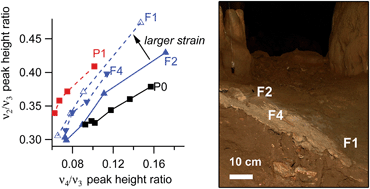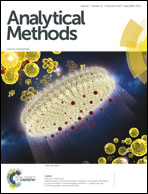Structural differences in archaeologically relevant calcite†
Abstract
We show that two different sources of calcite (geogenic flowstones and anthropogenic lime plaster) have complex, yet distinctive, structural disorder signatures. It is effective to identify these differences by pairing a rapid, fieldwork-compatible technique (Fourier transform infrared (FTIR) spectroscopy) with a robust laboratory-based technique (X-ray diffraction (XRD) peak width analyses). We demonstrate that crystalline domain size, microstrain fluctuations, and lattice strain each affect the FTIR spectra of calcite. To focus on each variable separately, XRD data and FTIR absorption spectra are compared among calcite samples formed by different processes. Small crystalline domain sizes cause changes to FTIR peak intensity ratios (grinding curves). However, larger microstrain fluctuations or larger lattice strain also produce similar changes. Thus, inferring structural differences from calcite FTIR spectra alone is not advisable. Instead, we advocate using FTIR grinding curves in conjunction with analyses of angle-dependent XRD peak widths using the Williamson–Hall relation. Thus, combining these two analysis techniques is more powerful and informative than using either one alone. These findings are relevant for heritage science, including archaeology.


 Please wait while we load your content...
Please wait while we load your content...